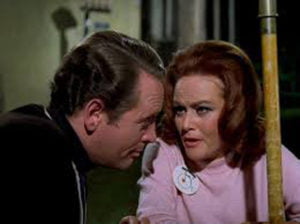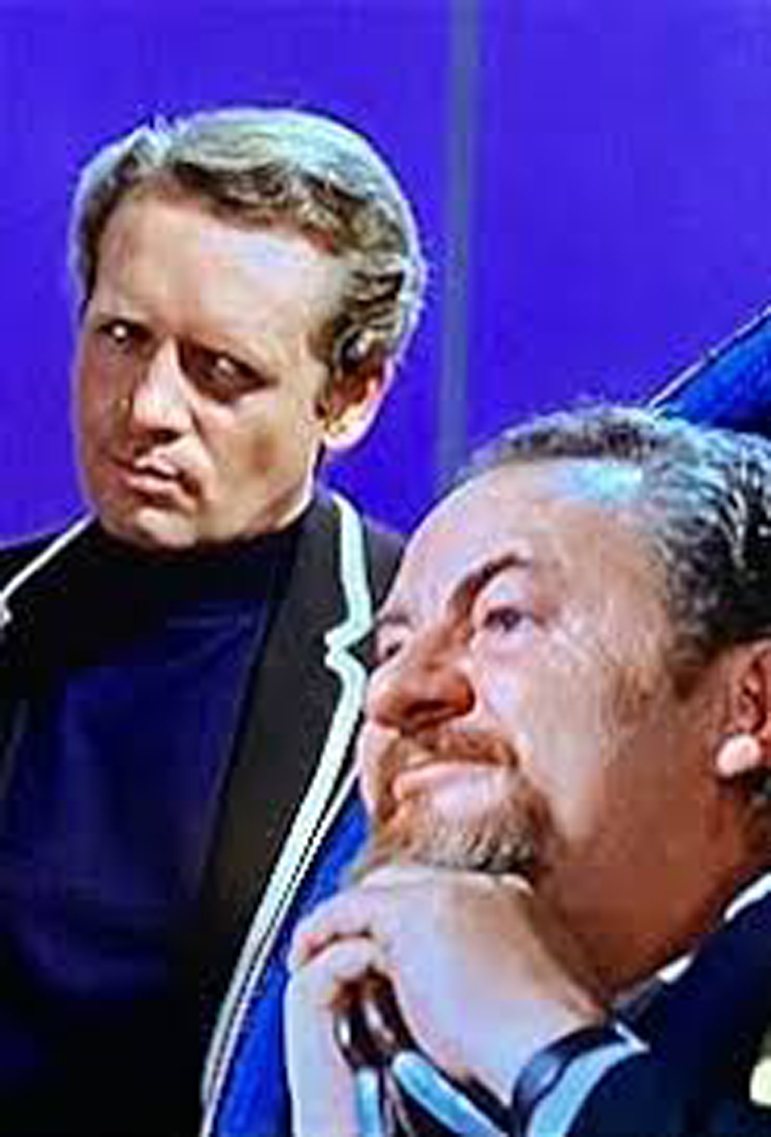THE CHIMES OF BIG BEN – EXTRACT

The Chimes of Big Ben,
the second episode of The Prisoner, is much less visually dazzling or verbally puzzling than the opening Arrival. The dialogue lacks the mysterious evasiveness and ambiguous menace of the opening episode. And while some effective use is made of the distinctively surreal Village iconography which had been established in the previous episode, here the main focus is on the story (concocted by experienced TV and film screenwriter Vincent Tilsley) which centres on an elaborate web of deception the Village rulers create in an attempt to extract vital ‘information’ from The Prisoner. The mechanics of the storyline, which lead up to him being apparently allowed to escape to his old Intelligence Service office in London, are somewhat contrived and melodramatic. The action sequence involving a sea chase by Rover is really rather unconvincing, as are the uncharacteristic hints of ‘romance’ between The Prisoner and Nadia, the Estonian woman he supposedly escapes with. And, not surprisingly, it looks (as indeed it was) much cheaper, very much more like a ‘TV show’ after the cinematic extravagances of Arrival.

Despite these limitations, Chimes introduces several key elements to the series. The question of why Number 6 resigned is given prominence, and the authorities’ continual attempts to get him to reveal this information is now established as one of the most important motifs of the series. The episode also marks the first appearance of Leo McKern as Number 2 (a role he will return to in the final two episodes) and throughout Chimes there is much jocular verbal sparring between him and The Prisoner. During one of their meetings The Prisoner points out to Number 2 that he is also a Prisoner, an accusation which Number 2 accepts with equanimity, and there seems clear evidence here (despite the fact that the episode appears to locate The Village in Lithuania) that the Village belongs neither to East nor West but is run by a third agency, a group which wishes to create a world wide totalitarian society …The whole world as the Village… as Number 2 puts it. Thus, although the episode appears to conform to many of the conventions of the Cold War spy-action genre (with Nadia’s relationship with Number 6 being rather reminiscent of that of Tatiana Romanova and James Bond in From Russia With Love) there are already hints of the broader and more allegorical Orwellian and Kafkaesque themes which will become more prominent as the series progresses.

The Chimes of Big Ben
The episode also introduces a certain tone of comic satire, particularly in its depiction of The Village’s ‘art and craft exhibition’ in which every artefact on show except for Number 6’s own creation is a picture or a sculpture of Number 2, clearly showing that the entire show is: rather than any form of ‘individual expression’: merely an expression of mindless conformity. Number 6’s own contribution is apparently an abstract sculpture which, as he explains to a group of pretentious Village ‘art critics’, represents ‘freedom’ and ‘escape’. In fact his sculpture is the actual boat he and Nadia will escape in.

The key contribution of Chimes to the series, however, is the way it sets up an often ironically conspiratorial tone which becomes a kind of duplicitous game which the audience is increasingly invited to participate it. This will build up over succeeding weeks’ episodes in a particularly intimate, televisual way; but one which will keep the audience guessing right up to the final episode. The Prisoner poses questions about the manipulative relationship between a TV series’ writers and their audience, continually challenging viewers to question what they are being presented with. When Nadia first arrives in The Village, The Prisoner himself seems to deliberately pretend to be one of the Village ‘authorities’, adopting a ‘superior’, knowing tone of voice and participating in the ‘Be Seeing You’ salute to passers by. Having previously been emotionally manipulated by the Village authorities, he naturally suspects that she is a ‘plant’ sent to entrap him.
Yet she appears to think that he is trying to trap her. It is only when he witnesses her being apparently tortured in the Village ‘hospital’ that he becomes convinced that she too is a ‘genuine’ Prisoner. In order to plan their escape together, the two fake a romantic relationship for the benefit of the watching Number 2. Nadia, as we will find out at the end of the episode, really is a Village agent but she continues to tease and flirt with The Prisoner throughout their ‘escape’, making the audience believe that (like Tatiana in From Russia With Love) she is now ‘coming over to our side’. Just as he is fooled, so are we.
It is only right at the end of the story that her role in the deception is revealed and we see that she has merely been skilfully (and cold heartedly) playing a part. Tilsley’s intricate plotting entices us carefully into this web of deception. When Number 6 pushes open the doors of what he thought was his London office and emerges back into the Village, his final ‘Be Seeing You’ is grimly rather than jokingly ironic. Thoroughly defeated, he has been taught a lesson in just how far the authorities will go to manipulate him. And the viewer has been expressly denied any moment of vicarious triumph. The denouement shows us that we, too have been subjected to the kind of ‘mind fucking’ that Number 6 has been put through.

The ending of the episode also raises a number of questions for the viewer. The assertion that the Village is located ‘in Lithuania near the Polish border’ now seems dubious at best. And as for the shots we’ve been shown of aeroplanes, lorries and containers being lifted onto ships, we can only conclude that these images are ‘subjective’ shots showing us what Number 6 expected to be happening.
Thus we may start to question just how much of what we are seeing is real and how much of it is in fact a projection of our eponymous hero. We are left with a nagging feeling that we were almost sucked in by the manipulation ourselves, despite the fact that surely we must realise that in a series entitled The Prisoner, it’s really far to early for the central character to escape. So despite the way in which it uses conventional elements of the ‘secret agent’ genre, The Chimes Of Big Ben ends up raising far more questions than it answers, and begins to make us question whether this is really any kind of ‘spy story’ at all.





Leave a Reply